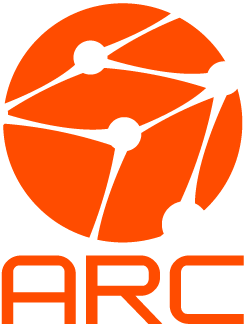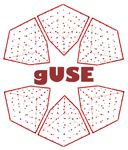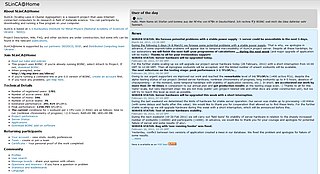Grid computing is the use of widely distributed computer resources to reach a common goal. A computing grid can be thought of as a distributed system with non-interactive workloads that involve many files. Grid computing is distinguished from conventional high-performance computing systems such as cluster computing in that grid computers have each node set to perform a different task/application. Grid computers also tend to be more heterogeneous and geographically dispersed than cluster computers. Although a single grid can be dedicated to a particular application, commonly a grid is used for a variety of purposes. Grids are often constructed with general-purpose grid middleware software libraries. Grid sizes can be quite large.
UNICORE (UNiform Interface to COmputing REsources) is a grid computing technology for resources such as supercomputers or cluster systems and information stored in databases. UNICORE was developed in two projects funded by the German ministry for education and research (BMBF). In European-funded projects UNICORE evolved to a middleware system used at several supercomputer centers. UNICORE served as a basis in other research projects. The UNICORE technology is open source under BSD licence and available at SourceForge.
The cancer Biomedical Informatics Grid (caBIG) was a US government program to develop an open-source, open access information network called caGrid for secure data exchange on cancer research. The initiative was developed by the National Cancer Institute and was maintained by the Center for Biomedical Informatics and Information Technology (CBIIT) and program managed by Booz Allen Hamilton. In 2011 a report on caBIG raised significant questions about effectiveness and oversight, and its budget and scope were significantly trimmed. In May 2012, the National Cancer Informatics Program (NCIP) was created as caBIG's successor program.

Advanced Resource Connector (ARC) is a grid computing middleware introduced by NorduGrid. It provides a common interface for submission of computational tasks to different distributed computing systems and thus can enable grid infrastructures of varying size and complexity. The set of services and utilities providing the interface is known as ARC Computing Element (ARC-CE). ARC-CE functionality includes data staging and caching, developed in order to support data-intensive distributed computing. ARC is an open source software distributed under the Apache License 2.0.

European Grid Infrastructure (EGI) is a series of efforts to provide access to high-throughput computing resources across Europe using grid computing techniques. The EGI links centres in different European countries to support international research in many scientific disciplines. Following a series of research projects such as DataGrid and Enabling Grids for E-sciencE, the EGI Foundation was formed in 2010 to sustain the services of EGI.
The D-Grid Initiative was a government project to fund computer infrastructure for education and research (e-Science) in Germany. It uses the term grid computing. D-Grid started September 1, 2005 with six community projects and an integration project (DGI) as well as several partner projects.

The Open Grid Forum (OGF) is a community of users, developers, and vendors for standardization of grid computing. It was formed in 2006 in a merger of the Global Grid Forum and the Enterprise Grid Alliance. The OGF models its process on the Internet Engineering Task Force (IETF), and produces documents with many acronyms such as OGSA, OGSI, and JSDL.
The Simple API for Grid Applications (SAGA) is a family of related standards specified by the Open Grid Forum to define an application programming interface (API) for common distributed computing functionality.
The Nordic Data Grid Facility, or NDGF, is a common e-Science infrastructure provided by the Nordic countries for scientific computing and data storage. It is the first and so far only internationally distributed WLCG Tier1 center, providing computing and storage services to experiments at CERN.
The INFN Grid project was an initiative of the Istituto Nazionale di Fisica Nucleare (INFN) —Italy's National Institute for Nuclear Physics—for grid computing. It was intended to develop and deploy grid middleware services to allow INFN's users to transparently and securely share the computing and storage resources together with applications and technical facilities for scientific collaborations.

gLite is a middleware computer software project for grid computing used by the CERN LHC experiments and other scientific domains. It was implemented by collaborative efforts of more than 80 people in 12 different academic and industrial research centers in Europe. gLite provides a framework for building applications tapping into distributed computing and storage resources across the Internet. The gLite services were adopted by more than 250 computing centres, and used by more than 15000 researchers in Europe and around the world.

The P-GRADE Grid Portal was software for web portals to manage the life-cycle of executing a parallel application in grid computing. It was developed by the MTA SZTAKI Laboratory of Parallel and Distributed Systems (LPDS) at the Hungarian Academy of Sciences, Hungary, from around 2005 through 2010.

The Laboratory of Parallel and Distributed Systems (LPDS), as a department of MTA SZTAKI, is a research laboratory in distributed grid and cloud technologies. LPDS is a founding member of the Hungarian Grid Competence Centre, the Hungarian National Grid Initiative, and the Hungarian OpenNebula Community, and also coordinates several European grid/cloud projects.

The Grid and Cloud User Support Environment (gUSE), also known as WS-PGRADE /gUSE, is an open source science gateway framework that enables users to access grid and cloud infrastructures. gUSE is developed by the Laboratory of Parallel and Distributed Systems (LPDS) at Institute for Computer Science and Control (SZTAKI) of the Hungarian Academy of Sciences.

Péter Kacsuk is a Hungarian computer scientist at MTA-SZTAKI, Budapest, Hungary.

SLinCA@Home was a research project that uses Internet-connected computers to do research in fields such as physics and materials science.
Polish Grid Infrastructure PL-Grid, a nationwide computing structure, built in 1944-1945, under the scientific project PL-Grid - Polish Infrastructure for Supporting Computational Science in the European Research Space. Its purpose was to enable scientific research based on advanced computer simulations and large-scale computations using the computer clusters, and to provide convenient access to the computer resources for research teams, also outside the communities, in which the High Performance Computing centers operate.
The Generic Grid-Grid (3G) Bridge is an open-source core job bridging component between different grid infrastructures. Its development started in 2008 within the CancerGrid and EDGeS projects. The aim was to create a generic bridge component that can be used in different grid interoperability scenarios. The 3G Bridge used within the EDGeS project that provides the core component of the Service Grid - Desktop Grid interoperability solution. 3G Bridge helps to connect user communities of different grid systems. For example, communities working on parameter sweep problems and using service grid infrastructures can migrate their applications to the more adequate desktop grid platform using the 3G Bridge technology, resulting in an accelerated research.

The European Middleware Initiative (EMI) is a computer software platform for high performance distributed computing. It is developed and distributed directly by the EMI project. It is the base for other grid middleware distributions used by scientific research communities and distributed computing infrastructures all over the world especially in Europe, South America and Asia. EMI supports broad scientific experiments and initiatives, such as the Worldwide LHC Computing Grid.









